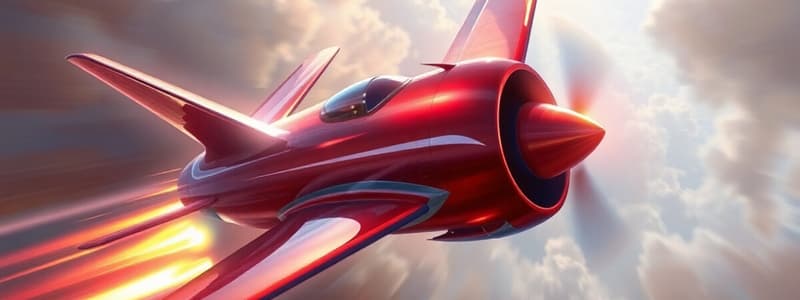Podcast
Questions and Answers
Why is it crucial to maintain the blade tip speed below the speed of sound?
Why is it crucial to maintain the blade tip speed below the speed of sound?
- To minimize the engine's fuel consumption.
- To reduce the noise produced by the propeller.
- To prevent vibration and loss of thrust due to shockwaves. (correct)
- To comply with air traffic control regulations.
What is the primary function of blade twist in a propeller design?
What is the primary function of blade twist in a propeller design?
- To increase the propeller's diameter for enhanced thrust.
- To reduce manufacturing costs by simplifying the blade's shape.
- To maintain the correct angle of attack along the blade's length. (correct)
- To allow for easier inspection of the propeller's surface.
Which of the following best describes the effect of increased rotational velocity on a propeller, assuming forward velocity is constant?
Which of the following best describes the effect of increased rotational velocity on a propeller, assuming forward velocity is constant?
- It decreases the angle of attack, potentially causing a braking effect.
- It maintains the optimal angle of attack, maximizing thrust efficiency.
- It has no effect on the angle of attack or thrust.
- It increases the angle of attack, potentially reducing efficiency. (correct)
What does the '74' component signify in a Sensenich propeller designation M74DMS5-2-60?
What does the '74' component signify in a Sensenich propeller designation M74DMS5-2-60?
If a propeller has a geometric pitch of 50 inches and an effective pitch of 35 inches, what is the propeller's slip?
If a propeller has a geometric pitch of 50 inches and an effective pitch of 35 inches, what is the propeller's slip?
What is the effect of propeller torque on aircraft stability if the propeller is rotating anti-clockwise when viewed from behind?
What is the effect of propeller torque on aircraft stability if the propeller is rotating anti-clockwise when viewed from behind?
Why is operating an engine within the 'red arc' range on the tachometer particularly dangerous?
Why is operating an engine within the 'red arc' range on the tachometer particularly dangerous?
What is the primary effect of Centrifugal Twisting Moment (CTM) on propeller blades?
What is the primary effect of Centrifugal Twisting Moment (CTM) on propeller blades?
How does increased forward velocity in a dive affect the angle of attack, assuming rotational velocity remains constant?
How does increased forward velocity in a dive affect the angle of attack, assuming rotational velocity remains constant?
What role does aerodynamic twisting moment (ATM) play in some propeller designs?
What role does aerodynamic twisting moment (ATM) play in some propeller designs?
Flashcards
What is Lift?
What is Lift?
Aerodynamic force on an aerofoil due to increased airflow velocity over its surface, creating lower pressure above and higher pressure below.
What is Drag?
What is Drag?
Force opposing thrust, resulting from airflow disruption over an aerofoil.
What is Thrust?
What is Thrust?
Forward-acting force, as a reaction to air accelerated rearwards, creating motion.
What is Blade Angle?
What is Blade Angle?
Angle between the chord line of a propeller blade and the plane of rotation.
Signup and view all the flashcards
What is Angle of Attack?
What is Angle of Attack?
Angle between the chord line and relative wind/airflow.
Signup and view all the flashcards
What is Blade Twist?
What is Blade Twist?
Gradual twist from hub to tip to maintain optimal angle of attack.
Signup and view all the flashcards
What is Geometric Pitch?
What is Geometric Pitch?
Distance a propeller should advance in one revolution.
Signup and view all the flashcards
What is Effective Pitch?
What is Effective Pitch?
Distance a propeller actually advances in one revolution, which is less than geometric pitch.
Signup and view all the flashcards
What is Propeller Slip?
What is Propeller Slip?
Difference between geometric and effective pitch, representing loss of efficiency.
Signup and view all the flashcards
What is Centrifugal Force?
What is Centrifugal Force?
Force tending to throw propeller blades away from the hub due to rotation.
Signup and view all the flashcardsStudy Notes
- Lift is the aerodynamic force created by air flowing over an aerofoil.
- An aerofoil shape increases airflow velocity over its surface, reducing pressure and creating lift.
- Propellers use lift as their basis of blade element theory.
- Drag opposes thrust caused by airflow disruption over an aerofoil.
- Thrust is a forward-acting force reacting to the mass of air accelerated rearwards.
- Momentum is a moving body's motion quantity, measured by mass and velocity.
- Total reaction is the resultant of lift/drag and thrust/torque pairs, acting simultaneously on the blade.
- Increased rotational speed raises these forces equally until blade tips approach the speed of sound.
Blade Angle
- Blade angle is the angle between the chord line and the plane of rotation.
- Measured in degrees relative to a datum point.
- The datum point is typically 75% of the radius from the propeller hub's center.
- Aircraft Maintenance Manuals and Type Certificates specify these angles and positions.
- For example: Sensenich propeller M74DMS5-2-60 has a 74-inch diameter and a 60-inch pitch at the 75% station.
Angle of Attack
- Angle of attack is the angle between the chord line and relative wind/airflow.
- Best results are typically between 2° and 4°, allowing air compression and expansion for thrust.
- It combines the aircraft's True Air Speed (TAS) and the propeller's rotational speed (RPM).
Blade Twist
- Blade twist is a gradual twist from hub to tip.
- It ensures a consistent angle of attack (2° to 4°) along the blade length.
- An additional consideration is avoiding shockwaves caused by tips reaching the speed of sound.
Pitch
- Pitch is the distance a propeller moves forward in one revolution.
- This can vary with different blade angles on variable pitch propellers.
Propeller Slip
- Propeller slip is the difference between geometric and effective pitch.
- Geometric pitch is a calculated distance through a solid medium in one revolution.
- Effective pitch is the actual distance in air.
- Example: A propeller with a 50-inch geometric pitch moves only 35 inches in air, making it 70% efficient with 30% loss.
- Most propellers operate between 75% to 85% efficiency.
Propeller Fundamentals
- Aerodynamic forces
- Centrifugal forces
- Thrust forces
- Torque
- Relative airflow effect on blade angle of attack
- Vibration and resonance
- If a propeller is driven anti-clockwise, it generates torque, affecting the aircraft's structure.
- This propeller torque tends to roll the aircraft clockwise.
- Counter-clockwise propeller rotation causes a clockwise torque reaction.
Propeller Gyroscopic Effect
- A rotating propeller resists changes in its plane of rotation.
- During a turn, the plane of rotation changes at a 90° angle to the applied force.
Propeller Slipstream
- A rotating propeller imparts rotational motion in the same direction.
- It can negatively affect the aircraft's fin, potentially causing the aircraft to turn.
- Contra-rotating propellers eliminate torque, slipstream, and gyroscopic effects by spinning in opposite directions.
- It straightens the slipstream and improves control.
Forces Acting on (Rotating) Propellers
- Centrifugal force tends to throw blades away from the hub.
- The results can amount to many thousands of newtons.
- Centrifugal Twisting Moment (CTM) is a force that rotates blades toward a fine angle on variable pitch propellers.
- CTM is usually greater than ATM, used by manufacturers to alter blade angles from coarse to fine.
Aerodynamic Twisting Moment (ATM)
- ATM is the force increases blade angle to a coarser angle.
- Some designs use ATM to aid feathering.
- Both ATM and CTM (torsional stresses) are quadratically increased with RPM increases.
Bending Forces
- Torque bending force: Air resistance (drag) bends blades opposite the rotation direction.
- Thrust bending force: Thrust bends blades forward.
Force Coupling
- Coupling centrifugal force and thrust creates severe stresses that are greatest near the hub.
- The blade face experiences tension from centrifugal force and bending.
- Propellers need to withstand these stresses, which increase with rpm.
- A simple scratch or dent can have severe consequences.
Propeller Angle of Attack
- Propeller performance depends on rotational velocity (rpm) and aircraft velocity (TAS).
- Performance (thrust) of a fixed-pitch propeller varies with changes in rpm or TAS.
Altered Rotational/ Forward Velocity
- Increased rotational velocity (at constant forward velocity) increases the angle of attack.
- Increased forward velocity (at constant rotational velocity) decreases the angle of attack.
- This may lead to a negative angle of attack, turning the propeller into a brake.
- Changing either the rotational or aircraft velocity alters the propeller's angle of attack.
- Varying the propeller's angle of attack beyond its designed parameters reduces efficiency.
Blade Tip Speed vs. Efficiency
- Larger propellers allow engines to absorb more power but can lose efficiency.
- This is through tip vibration or flutter from shock waves approaching the speed of sound (approximately 1200 ft/s or 660 kt).
- Propeller tips must stay below the speed of sound while still absorbing available engine power.
- Can achieve this by increasing number of blades or altering blade shape and section.
Blade Vibration
- Blade vibration occurs due to aerodynamic and mechanical forces.
- Aerodynamic forces cause buffeting and vibration by bending blades forward.
- Mechanical vibrations from engine power pulses are more destructive.
- They cause standing wave patterns, leading to metal fatigue and structural failure and are most critical around 6 inches from blade tips.
- Most designs have eliminated detrimental effects of vibrational stress through careful design.
- Critical range is indicated on the tachometer by a red arc.
- Engine operation in the dangerous range should be limited to a brief passage from one rpm setting to another.
Studying That Suits You
Use AI to generate personalized quizzes and flashcards to suit your learning preferences.




